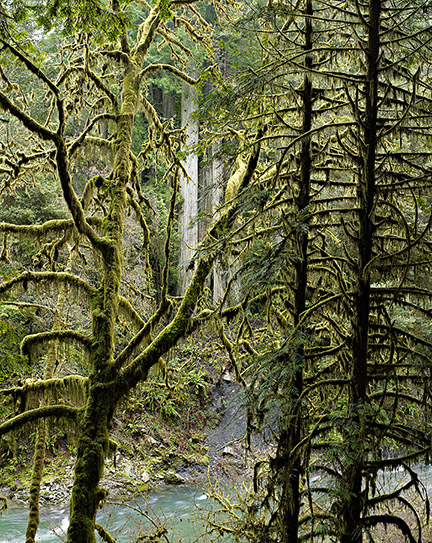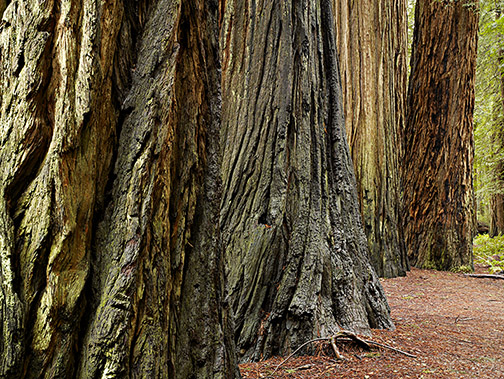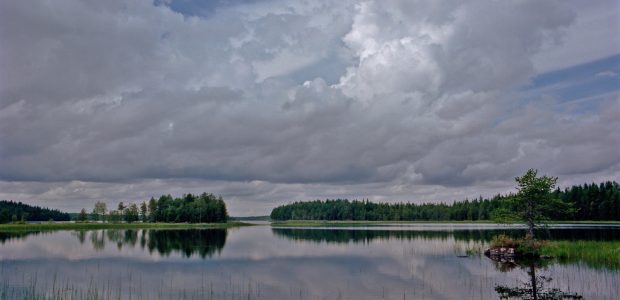A River Runs Through
Redwoods National Park – March, 2006
Linhof 679cs with Phase One P45 back and 100mm Rodenstock APO Sironar HR digital lens
In mid-March, 2006 I spent a week shooting in central and northern California. Our travels took us toRedwoods National Park, the northern reaches of coastalHighway 1,Yosemite National Park,Big Sur,Point Lobos, and numerous points in between. Other than a lot of driving, not much makes this a trip worthy of special comment other than the fact that I was shooting for the first time with a newdigital view camera system, consisting of aLinhof 679cstechnical camera, aPhase One P4539 Megapixel back, and fourRodenstockdigital lenses.
Again – taken separately none of these items merits special mention, other than possibly the P45 back, which, because it is the highest resolution digital back currently available, and only started shipping recently, will be new to many people.
Also worth mentioning was that I was shooting with three other photographers (for the 2 days that we were in the Redwoods parks), and each of them were also shooting with P45 backs.Bill Atkinsonwas one,Charles Crameranother, and the third wasKevin Raber. The fifth member of our party wasChris Sandersonthe videographer of theVideo Journal.
Bill is widely known as a fine art landscape photographer as well as one of the world’s leading experts on colour management and printer profiling. He also was one of the original developers of theMacintoshcomputer. Charlie is a landscape photographer of repute, and also a well known photographic educator. Bill and Charles frequently teach together at some of the leading photographic centers, and both also write extensively for major magazines and technical publications.
Kevin isU.S. Vice President of Phase One, but was with us in his capacity as a personal friend, frequent shooting companion, and ardent photographer. And, just to keep the record straight, each of Bill, Charlie and I purchased our P45 backs from retail dealers. The advantage of having Kevin with us (other than his very enjoyable company) is that he provides a very direct pipeline back to the factory and Phase One’s engineers and developers. Since neither the P45 nor Capture One are perfect, working with Kevin in the field with a new product also provides his company with real-world feedback.
For both Bill and me this was our second Phase One medium format digital back. We both had been using the 22 Megapixel P25 for the previous year, and I had used theKodak DCS Probackprior to that. For Charlie this was his inauguration into to using a digital back for landscape work. For the past thirty years he has been shooting with 4X5" film.
What made this shoot of particular interest for me was not only the use of the P45 but also that for the first time in about 15 years I was returning to using a view camera in the field. I have used 4X5" in the past extensively, mostly in the studio, as well as some architecture and landscape work. I’d also been theSinarview camera product manager in Canada for several years, but I’ve been doing my fine-art landscape work for the past decade or so with medium format digital and film. I was very curious to see how the transition back to using a view camera would be. I’d made a fairly substantial commitment to the switch over, and was as curious as some readers as to how it would go.
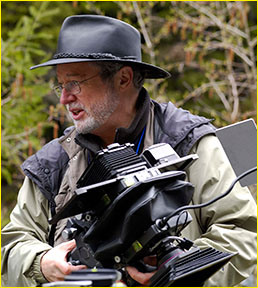
Me, my hat, and my Linhof, working in the drizzle
Photograph by Kevin Raber
_____________________________________________________________________
Let’s Get Technical
Working with a technical camera in the field offers both challenges and advantages. The Linhof 679 is smaller than a 4X5" camera, as are its lenses, but it’s also more bulky than a medium format camera system. Not the lenses though.
A friend commented that the more large format lenses you have the lighter your system gets. He meant in comparison to medium format. The reason for this is that LF lenses have no focusing mounts, are as simple as a lens can be, and thus are much lighter in weight than a comparable MF lens.
All in all I found working with the Linhof in the field to be a pleasure. This is saying something, because during our week in California we encountered every form of precipitation known; from rain to snow, to sleet, to hail. We also had bright sunshine, overcast skies, high winds, and temperatures from as low as 25F to as high as 60F.
The Linhof, four Rodenstock lenses, P45 back, sliding adaptor and various accessories, including light meter and filters, all fit nicely in aThinkTank AirportAddictedbackpack. It weighed in at 35 lbs fully loaded. Heavy (the bag alone weighs almost 10 lbs), but manageable for hikes of up to a mile or so.
I usually would set the camera on the tripod for the first shot of a hike, and then would simply continue afterward with the cameras, lens, and back remaining attached to the tripod and slung over my shoulder. This made for setting up subsequent shots much quicker, but I have to be honest, also entailed some trepidation when walking under trees with low hanging branches. The thoughts of hitting the P45 on a branch, or worse yet, tripping on a root or rock, made me understandably nervous. Of course I was also always very careful to ensure that all lock knobs were securely fastened before hitching the rig over my shoulder.
Needless to say, working with a view camera is slower than working with an SLR. But surprisingly, not by that much when one is doing landscape and nature photography. This is by definition a somewhat slow and contemplative process, and so the need to open the lens for viewing for composition, and then manually cock the shutter, close the aperture and close the pre-set, as well as slide the viewer and back into position, only adds seconds to the process. When movements are used, of course these take time to set up. But for straightforward shooting all that’s needed is to ensure that all camera movements are properly zeroed.
Of course focusing on an upside down image on a groundglass is slower than through the viewfinder of an SLR, but as I’ve written before, is something one gets used to fairly to quickly, even if one hasn’t done so in a while, or even ever before.
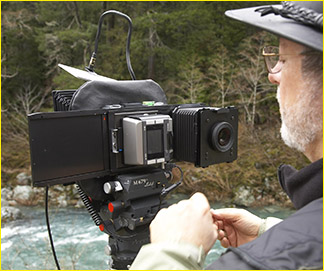
Photography by Kevin Raber
Overall I would judge that going from setting the tripod on the ground to taking the typical shot (including changing lenses, if need be) takes about 5-6 minutes with the Linhof / P45 combination, while doing so with a Hasselblad H2 might take half that time, if not a bit less.
But the flip side of this somewhat slower shooting pace is the availability of camera movements. From perspective correction to the use ofScheimpflugeffect with its extended plane of focus, there is so much that can be done with camera movements when doing landscape work that I have always found not having them available restrictive. In addition to 4X5" film-based cameras, I have used tilt shift lenses on myCanongear as well as on myContax 645. I also have used aHasselblad Arcbodyfor some time and found it to be an excellent light-weight field tool – regrettably now discontinued.
The real difference when shooting with a contemporary technical view camera like the Linhof 679, along with a digital back and sliding adaptor, and a 4X5" camera with sheet film, is the ease of rapid shooting. Lower operating cost is also a significant consideration, as is not having to spend ones evenings on the road in a light-sealed motel bathroom, unloading and reloading sheet film holders.
_____________________________________________________________________
The P45 in Use
Linhof 679cs with Phase One P45 back and 55mm Rodenstock APO Sironar digital lens
Frankly, shooting with the P45 was pretty much like shooting with the P25. These backs are physically identical, and only the resulting larger and higher resolution files let one know that anything much has changed.
I did note lower battery life. Though I have no hard numbers to back it up, I would judge the P45 to provide only about half the battery life of the P25. I own four batteries and have never run out even on the busiest day’s shooting with the P25, but I now plan on buying a couple more batteries, just to be on the safe side when working in remote locations.
Update: March 29, 2006
Apparently the P45 ships with a 2500 mAh battery, while the batteries that came with the P25, and which are generally available, are 2000 mAh. Since I upgraded, I didn’t get the new battery, as Phase One only provides the naked back to upgraders rather than the full kit, with accessories, fitted Pelican case, etc. This higher capacity battery should go a long way toward addressing the higher battery drain that I’ve noted.
As for the weather – it didn’t make much of a difference for any of us, either me with my Linhof, or Bill and Charlie with the Hasselblad and Mamiya systems. We all kept shooting regardless of the precip, just keeping our gear covered with plastic bags as needed when the rain got really heavy.
I should add that as I had experienced in a wide range of weather conditions over the past 12+ months with the P25 (the P45 and P25 are physically identical), there was no issue with sensitivity to moisture or cold weather. My P backs have worked without fail from the desert to the Antarctic, so a bit of California rain wasn’t about to cause any concern.
Nevertheless, I have to markPhase Onedown a notch for still not providing their customers with plugs for the camera’s various interface connectors. I complained about this two years ago, and it still hasn’t been addressed. These openings are exposed to the elements and are a potential source of trouble for anyone working in the field. I’ve been solving this by putting black electrical tape over the holes as a form of protection, but it really looks tacky, and they aren’t as well sealed as they would be with properly fitting rubber plugs.
We did have one technical fault, and it occurred to each of us. By coincidence we were all shooting withSandisk Extreme IIIcards in our P45s, and each of us experienced error warnings. I switched to my backup 4GB Microdrives, and the others toUltra IIandLexar 80Xcards, and had no further trouble. This was reported to the factory by Kevin, and within a couple of days we received confirmation that this is indeed a bug. To quote a Phase One rep…"What has been found is that the latest firmware for P45/30/21 (v1.9.4) has been optimized for Extreme III cards and this optimization can give unstable card handling in bellow 0 C. temperatures. We are currently working fixing this in an upcoming firmware release."
Update: March 29, 2006
Phase Onehas responded quickly to this problem. There is now a new firmware download available for P21, P30 and P45 backs that corrects the low temperature problem withSandisk Extreme IIIcards.
_____________________________________________________________________
A Note Regarding Camera Movements
BothIn The Redwoods, above, andLog Bridge, below, are photographs that could not have been taken with the same effect and quality without the use ofScheimpflug. Through the use of a swing movement in the shot above I was able to secure apparent depth of field from the bark on the nearest tree a few inches away to the most distant part of the scene. In the photograph below the use of a lens tilt meant that the image could be kept sharp right from foreground to background, even at a modest aperture. Since the light levels were very low in both cases (though it doesn’t appear to be the case, each had exposures of several seconds) there was no need to stop down the lenses very far and thus incur the risk of degraded resolution due to diffraction effects.
One additional thought on the use of camera movements – the Linhof 679 is a yaw free camera. This means that the swing and tilt movements take place though the center optical axis of the lens. This makes the use ofScheimpflugmovements very easy. Just focus in the center of the image, then tilt or shift until the desired near and far points are sharp. On a camera with yaw, getting in focus when movements are used can be an iterative process that is frustrating and time consuming.
_____________________________________________________________________
Final Analysis
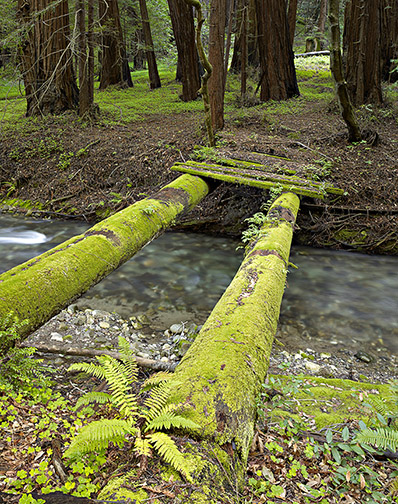
Log Bridge. Big Sur, California. March, 2006
Linhof 679cs with Phase One P45 back and 55mm Rodenstock APO Sironar digital lens
I couldn’t be more pleased with the way this new system worked out for me. The flexibility of doing landscape work once again with a camera system with full movements is most welcome. The Linhof will also be an important part of my kit when it comes to a long term architectural commission that I’m working on.
As for the P45, it too has met expectations. I won’t say much more at this point as I have a major multi-back, multi-camera comparison coming up in the weeks ahead. But, it should be understood that the P45 offers image quality which I regard to be at least the quality of drum scanned 4X5" film, and with much less work and lower long-terms cost.
The Rodenstock lenses didn’t disappoint either, offering superb image quality. Whether they exceed Hasselblad or Mamiya lenses will also have to await my upcoming comparison.
The onlyAchilles Heelof the entire system (and this is true of all technical (view) cameras), is that unless one pays very close attention to the centering of all movements, inadvertent errors are all too easy. In the studio this is a less significant issue, but in the field, loading the camera in and out of a backpack, or carrying it over ones shoulder attached to a tripod, it is very easy for a swing or shift movement to become slightly skewed. This then leads to out of focus images. It happened to me often enough on this trip that I became really paranoid about it. Fortunately, because I was shooting digital, and was able to check my files each evening, I caught the problem in the bud. Something to consider.
In fact I did consider it further, and decided that while the Linhof will be a great system for working out of the car, or on traditional locations, it really isn’t that well suited to the kind of very rugged field work that I sometimes do. For example, on an upcoming workshop / shoot in Namibia (April, 2006), we’ll be doing quite a bit of hiking over sand dunes on hot weather. A 35lb pack isn’t going to cut it for me, and so I will be using a Hasselblad H2 system with my P45 for this type of use.
_____________________________________________________________________
Counting Ants
Oh yes! Why the title –Counting Ants? Simple because at the end of each day we’d look at our image files on our laptops, and the comment was often heard that if there had been an ant crawling along a branch 50 feet away on a shot taken with a wide angle lens, it would show up (sharply) on shots taken with the P45. Said in jest, and since there were no ants present this time of year, hard to prove or disprove. But, nevertheless, indicative of how bowled over each of us was with the image quality and resolution that the 39 Megapixel P45s were giving us.
March 2006
You May Also Enjoy...
Next Level Part III
Part Three of a Three Part Series In thefirstof the three part series on ‘Finding Your Level And Moving On’ we defined the levels. In
Research Project About Elsa Johanna – Luminous-Endowment Grant Winner
FacebookTweet The Mylio Grant – Laura J. Bennett – Auburn, California Grant Amount $2,500 USD I was awarded The Mylio Grant through The Luminous Endowment
